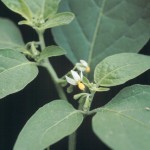Black Nightshade
Solanum ptycanthum
Solanaceae (Nightshade family)
Description
Black nightshade, also called deadly nightshade, was known in the past as Solanum americanum or Solanum nigrum. This plant is a dark green, slender-branched, hairless annual growing as tall as 3 feet.
The gently pointed oval leaves have smooth margins. White or purple- tinged flowers are about 0.25 inch in diameter. They give rise to small clusters of round, green fruit that turn black at maturity.
Habitat
Black nightshade is found across Texas and most of the eastern half of the United States. Within Texas, it is more abundant in the eastern half. These plants often grow in thickets, openings in woods and in disturbed soil and spread into cultivated fields.
Toxic Agent
The toxic agents of black nightshade are glycoalkaloids like those found in the other nightshades. This plant, though called deadly nightshade, is probably less toxic than some of the other common species. This is not the same plant as the European black nightshade (Solanum nigrum).
Its broad distribution and frequent evidence of having been grazed without associated livestock poisonings support its relative safety. Unlike many other nightshade species, its fruit is suspected to be more toxic when green than when ripe. Poisonings occur only when large amounts are consumed.
Signs of Livestock Ingestion
The signs of poisoning may be related to the nervous system or the gastrointestinal tract. They may include: Anorexia; Depression; Excessive salivation; Diarrhea or constipation; Muscle trembling; Weakness; Colic.
The very small seeds may be found in the gastrointestinal contents of dead animals.
Management Strategies
Avoidance is the best insurance against this plant. At times, black nightshade may almost cover pens that have been vacant for some time. Do not use the pens if green fruits are present.
Images
Plant Characteristics
Flower Color: White
Seed Type: Fruit/Berry
Duration: Annual
Stem Texture: Hairless/Smooth
Growth Habit: Forbs/Broadleaf
Leaf Shape
 : Simple with Pinnate or Parallel Venation
: Simple with Pinnate or Parallel Venation
Season: Warm
Distribution
 : 01 - Pineywoods, 02 - Gulf Prairies and Marshes, 03 - Post Oak Savannah, 04 - Blackland Prairies, 05 - Cross Timbers and Prairies, 06 - South Texas Plains, 07 - Edwards Plateau, 08 - Rolling Plains, 09 - High Plains, 10 - Trans-Pecos
: 01 - Pineywoods, 02 - Gulf Prairies and Marshes, 03 - Post Oak Savannah, 04 - Blackland Prairies, 05 - Cross Timbers and Prairies, 06 - South Texas Plains, 07 - Edwards Plateau, 08 - Rolling Plains, 09 - High Plains, 10 - Trans-Pecos
Distributions
Distribution refers to the ecological region in Texas that a plant has been found. You can also view a clickable map.
Book: Toxic Plants of Texas (B-6105)
Collection: Toxics
Livestock Affected: Cattle, Goats, Horses, Sheep
Livestock Signs: Abdominal Pain, Colic, Collapse, Coma, Depression/ Weakness, Diarrhea, Excess Salivation, Irregular Breathing, Nitrate Poisoning, Unable To Rise, Vomiting/Regurgitation





